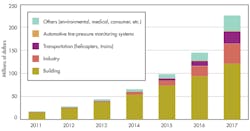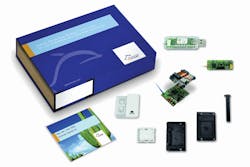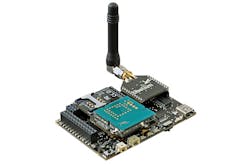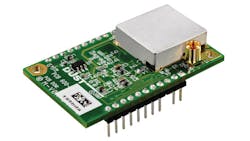Energy Harvesting And Wireless Sensor Networks Drive Industrial Applications
This file type includes high resolution graphics and schematics.
The industrial sector is keen on using electronics for greater capabilities and higher efficiencies and productivity. Smaller and smarter sensors, ultra-low-power IC devices, energy harvesting performance advances, and better wireless sensor network protocols are spurring this trend.
Related Articles
- Power Your Wireless Sensors For 40 Years
- Expect More Energy Harvesting To Power Wireless Sensors In 2013
- Industrial Environments Require Rugged Design
There are many rotating, shaking, and vibrating machines and structures in industrial environments where physical motions, thermal and RF emissions, and magnetic photo-optic properties can produce electrical output signals. In a typical energy harvesting system, energy is generated from motion, a thermal source, magnetic activity, or a photovoltaic source. The energy is then captured, stored and managed, and fed to a sensor and transmitter.
Electric motors are one of the biggest sources for energy due to their mechanical and thermal characteristics. They proliferate widely on the factory floor. Many experts estimate that the total cost of industrial electric motor ownership can be substantial and can dissipate more than 90% of the plant’s expended energy.
Although modern electric motor efficiencies have been pushed up to 90% to 95% thanks to more efficient power ICs, optimizing a motor system’s operation could save more than 20% of the energy expended. Moreover, energy harvesting devices are available to convert the mechanical energy (due to vibration) and thermal energy (due to heat) given off by electric motors. This converted energy, with the help of low-power circuits designed for energy harvesting, can be boosted to work with wireless sensor networks for even more energy savings.
Until the recent past, though, there weren’t many practical ways to convert these signals to a useful end. Most energy harvesting modules and devices can only produce milliwatts of output power and need to work with front-end devices that can boost and manage this power before sending it on to wireless sensor networks.
Advances in energy harvesting and storage techniques, as well as the availability of low-energy front-end ICs that can boost these signals, combined with better wireless sensor communications technology, are radically changing this scene. These improvements are enabling the monitoring and control of a slew of industrial applications like plant equipment, chemical and many other processes, infrastructure systems, commercial buildings, and geophysical phenomena.
The result has been greater efficiency and reliability levels for these applications, along with the benefits of an eco-friendlier and greener environment. IC manufacturers like Linear Technology Corp. (LTC), Texas instruments (TI), Micro Semi Corp., Advanced Linear Devices (ALD), and Maxim Integrated Products are avid about providing supporting devices that can assist in working with energy harvesters and wireless sensor networks.
On The Market
Yole Développment sees a growing market for energy harvesting modules. Combined with building automation and industrial applications, they will constitute the largest segment of the market by 2017, which today is only a small fraction (Fig. 1). The market research firm pegs the market at $45 million next year, growing to $227 million by 2017. It predicts that mechanical and thermal energy harvesting will be responsible for 39% and 15% of the market respectively.
For example, TI offers the TMS37157 passive low-frequency antenna interface IC, which, together with the TI MSP430 MCU, can be used to harvest energy from photovoltaic, thermal, and vibration sources for transmission over wireless sensor networks. LTC’s LTC3105 step-up dc-dc voltage converter and LTC3108/3109 step-up converters with power management can work with the same type of energy sources. ALD’s EH42xx is another voltage step-up converter designed for energy harvesting sources.
Maxim Integrated Products has showed off a drop-in 16-bit analog front-end solution for industrial sensors in the form of the Cupertino reference design (Fig. 2).It meets the needs of industrial sensors, process control, and programmable logic controllers (PLCs) by providing fully isolated power and data lines, high resolution, and a wide range of input voltages.
The Cupertino’s analog –10- to +10-V, 0- to 10-V, and 4- to 20-mA inputs support the ubiquitous analog outputs of industrial sensors. It acts as an interface between the sensor and the controller all in a small 96.52- by 20.32-mm form factor, and it connects directly to FPGA/CPU development kit expansion ports that conform to the Pmod standard from Digilent Inc.
There is no widescale agreement that microelectromechanical system (MEMS) sensors will dominate energy harvesting in the industrial sector, though. The technology’s potential was discussed during the recent MEMS Industry Group’s MEMS Executive Congress one-day panel session in Amsterdam, Holland.
Wim Sinke, program development manager at the Energy Research Center of the Netherlands, and Eric Yeatman, professor of micro-engineering the United Kingdom’s Imperial College of London, support photovoltaics, peltier effects, and wind energy as sources for working with energy harvesting devices as MEMS sensors may find niche supporting applications. Robert Andosca, CEO of MicroGen Systems Inc., agreed but countered that a small amount of energy can be used to save a large amount in a leveraging effect.
Andosca was referring to his company’s plans to shortly unveil a Bolt line of MEMS-based micro-power single-frequency vibration energy harvesting generators with outputs greater than 10 V and an output power of more than 100 µW at less than 0.1 to 0.5 g. An operational frequency of 120 Hz is available, as are custom-designed units for an frequency range of 100 to 1500 Hz.
The sensors use the piezoelectric effect to detect vibrations like those of motors and other machinery. Their outputs can be used with energy harvesting boards that include advanced thin-film batteries or ultra-capacitors and power management electronics for wireless and sensor fusion applications.
MEMS For The Environment
MEMS technologies are finding a great deal of success in environmental, infrastructure monitoring, building automation, and geophysical explorations of natural resources. Also, improvements in the manufacturing of MEMS sensing technology are moving forward.
In a $36 million project partially funded by European taxpayers, STMicroelectronics NV in Switzerland has begun working with research partners to develop a 200-mm wafer pilot line for next-generation MEMS devices, augmented with technologies such s piezoelectric and magnetic materials as well as 3D packaging. These materials are important sources for energy harvesting.
The 30-month Lab4MEMS project’s key is to perfecting a lead-zirconate-titanate (PZT) deposition process compatible with mass production and integrating it into established MEMS processes. The researchers hope to use it to enable the development of innovative actuators, sensors, and micro-pumps to meet future demands of smart-building, energy harvesting, industrial control, consumer electronics, healthcare, and automotive applications.
Building automation is a prime application area.Market research firm ABI Research estimates that the building automation services market will reach a value of $43 billion by 2018. Greater environmental and financial demands are driving a new round of growth.
These factors have raised the appeal of reducing energy consumption in commercial buildings and the benefits for optimizing building automation systems. A new level of connectivity now stretches the reach of building automationsystems from new sensors and actuators to cloud computing application management and data analysis.
After Hewlett Packard Co. announced its ultra-high-sensitivity MEMS accelerometer for wireless sensor infrastructure monitoring and geophysical applications a couple of years ago, it teamed up with Royal Dutch Shell for wireless sensor network oil and gas exploration.
This file type includes high resolution graphics and schematics.
Singapore’s A*Star has followed suit by teaming up with Norway-based Petroleum Geo-Services (PGS) to develop a MEMS-based sensor for deep-sea oil and gas exploration. Sensors from A*Star’s Institute of Microelectronics will be incorporated into PGS’s commercial streamer system to acquire more precise seismic data to locate and estimate the size of offshore energy reserves. The streamer systems are towed behind large ships.
Many thermal-based MEMS sensors are being used worldwide to measure gas flows and other types of flows. MEMSIC’s MFA1100R was one of the earliest sensors. The company has since introduced the MMC246xMT for industrial/magnetic field measurements in roadway traffic control and parking management applications, besides consumer electronics navigational uses. The low-noise, ±6-gauss, two-axis low-power device is housed in a tiny 2- by 2- by 1-mm package and can be embedded in roadway lanes where its magnetic field can be conveniently measured to gauge traffic.
An ambitious “Sensing City” project for Christchurch, New Zealand, which undoubtedly involves many MEMS sensors, is in the works to allow the city to monitor and manage livability metrics. The project will enable informed planning decisions, real-time dynamic transport management, sustainable city measures, and environmental impact management.
Supported by the city’s council, Christchurch will install sensors in public infrastructure buildings and spaces and in private sources where the owners agree to join in. Sensors would measure aboveground and underground events including potential earthquakes. The overall plan is to make all measurement information public for complete transparency and to allow private enterprise its own solutions. The plan also would bar the measurement of the activities of individual people to ensure complete privacy and that anything that can be measured and can be of value should be measured, even if it is discovered later after the implementation stage.
Vibrations Aid Energy Harvesting
The Centre for Smart Infrastructure and Construction (CSIC) in the U.K. is pursuing a novel approach to piezoelectric MEMS sensing using perpendicular micro cantilevers, not the usual transversal ones, to generate more energy from the same amount of vibration. It’s designed to power remote monitoring devices where access is limited such as inside a tunnel or underneath a bridge.
Prototype versions of MEMS and macro-scale devices based on this principle have demonstrated a significantly improved power output and a wider operation bandwidth compared to existing state-of-the-art devices. The device is being commercialized by Cambridge Enterprise, the University’s technology transfer office.
One of the largest producers of vibration energy harvesting products is Germany’s EnOcean. Its ESK300 starter kit for wireless sensor networks consists of a switch module for building services, components for different applications, a temperature sensor module, a USB gateway, PC software for visualization, and a sample case for industrial applications (Fig. 3). The kit’s ECO 200 is an energy converter of linear motion and can be used to power EnOcean’s PTM 330C radio module.
The company has formed the EnOcean Alliance, a consortium of companies worldwide working to further develop and promote self-powered wireless monitoring and control systems for sustainable buildings by formalizing the interoperable wireless standard. The Alliance has the largest installed base of field-proven wireless building automation networks in the world.
Another leading vibration energy harvesting company is the Perpetuum in the U.K. Its FSH electromagneticharvesters convert mechanical vibration energy to electrical energy via an oscillating mass (magnet) that traverses across a fixed coil creating a varying amount of magnetic flux, inducing a voltage according to Faraday’s law.
To maximize power output, the harvester is mechanically tuned to an optimized resonant frequencypresent within the application environment. According to the company, the FSH can eliminate the need for battery replacement even at data collection update rates of more than five per second.
Wireless Sensor Networks
Presently, wireless sensor networks require some sort of energy storage such as conventional and solid-state batteries. But eventually, many experts predict, battery-less wireless sensor operation will be practical in some applications.
Imec at its Holst Centre in Eindhoven, the Netherlands, and Renesas Electronics Corp. have entered into a strategic research collaboration to enhance ultra-low-power wireless technologies for short-range communication, targeting sensor networks for automotive and industrial purposes. Renesas will jointly develop multi-standard radio solutions for small battery-operated or harvested wireless handheld devices.
By combining innovative architectures, advanced ultra-low-power design intellectual property (IP), and efficient low-power circuits, Imec’s radios achieve best-in-class performance and reduce power consumption by a factor of three to 10 lower than today’s radios. They also comply with state-of-the-art wireless standards, such as Bluetooth Low Energy (2.4-GHz band) and ZigBee (2.4-GHz band).
LTC supplies the SmartMesh system-on-chip (SoC), which, together with the LTP5900 module, allows the lowest power consumption for wireless sensor networks, according to the company. Power consumption is a measly 50 µA per wireless network node.
Libelium has launched a new generation of Waspmote sensor nodes for its open-source wireless sensor network platform (Fig. 4). Designed with inputs from a community of more than 2000 developers over four years, it has brought improvements to the Waspmote platform that combine the flexibility of the initial design with field and test-bed experience gained from 20,000 units sold worldwide.
A chief improvement to the Waspmote platform concerns its energy efficiency. Power consumption has been reduced to 0.07 µA in its hibernation mode. Other extended features include refinements to the hardware platform and software application programming interface (API), as well as a code generator with a graphic interface that allows the Waspmote to be programmed easily by anyone.
Several IC companies offer wireless sensor network transceivers optimized for low-power consumption that work with energy harvesting sources. Microsemi’s ZL70250 dissipates less than 2 mA at a supply voltage of 1.2 to 1.8 V, operates from 795 to 965 MHz, and features 0-dBm power-up transmission and –90-dBm sensitivity. The company recently teamed up with Mesh Virtual Extension to enable what it calls the lowest-power sub-gigahertz mesh network for coin-cell powered and energy harvesting applications using the ZL70250.
TI has just released the most integrated ZigBee single-chip solution with an ARM Cortex-M3 microcontroller unit for smart energy infrastructure, home and building automation, and intelligent lighting systems. Its CC2538 SoC supports the ZigBee Pro, ZigBee Home Automation, and lighting standards protocols. It also supports IP standards-based development using the IEEE 802.15.4 and 6LoWPAN IPV6 protocols.
The Eterna transceiver chips from Dust Networks (now part of LTC) implement the IEEE 802.15.4e protocol. Together with SoCs, this second-generation product features power dissipation levels 50% less than the earlier generation it replaces (Fig. 5). Dust Networks claims that products based on its Eterna technology dissipate eight times less power consumption than competitive offerings, which means they can last eight times longer and can be eight times “greener” even if they’re line-powered.
It should be noted that the term “mote” was widely popularized by Dust Networks and is part of the company’s WirelessHart mesh communications network, based on work performed by company founder Kris Pister while he was at the University of California at Berkeley. WirelessHart is a recognized international communications protocol standard and has led to the formation of the HART Communication Foundation.
This file type includes high resolution graphics and schematics.
About the Author
Roger Allan
Roger Allan is an electronics journalism veteran, and served as Electronic Design's Executive Editor for 15 of those years. He has covered just about every technology beat from semiconductors, components, packaging and power devices, to communications, test and measurement, automotive electronics, robotics, medical electronics, military electronics, robotics, and industrial electronics. His specialties include MEMS and nanoelectronics technologies. He is a contributor to the McGraw Hill Annual Encyclopedia of Science and Technology. He is also a Life Senior Member of the IEEE and holds a BSEE from New York University's School of Engineering and Science. Roger has worked for major electronics magazines besides Electronic Design, including the IEEE Spectrum, Electronics, EDN, Electronic Products, and the British New Scientist. He also has working experience in the electronics industry as a design engineer in filters, power supplies and control systems.
After his retirement from Electronic Design Magazine, He has been extensively contributing articles for Penton’s Electronic Design, Power Electronics Technology, Energy Efficiency and Technology (EE&T) and Microwaves RF Magazine, covering all of the aforementioned electronics segments as well as energy efficiency, harvesting and related technologies. He has also contributed articles to other electronics technology magazines worldwide.
He is a “jack of all trades and a master in leading-edge technologies” like MEMS, nanolectronics, autonomous vehicles, artificial intelligence, military electronics, biometrics, implantable medical devices, and energy harvesting and related technologies.






